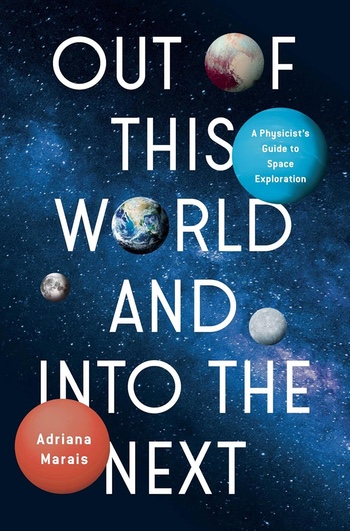Review: Out of This World and Into the Nextby Jeff Foust
|
| Oddly, for all her interest in Mars exploration, there’s one set of relevant experiences Marais says little about in the book. She was one of the thousands of applicants for Mars One. |
Amid this interest in Mars exploration comes Out of This World and Into the Next by Adriana Marais, a theoretical physicist by training who is an advocate for space exploration, especially Mars. Despite being billed as a guide to space exploration, the book has a broader scope that results in something underwhelming.
Space exploration does not factor much into the early portions of the book, where Marais goes into topics like cosmology, planetary science, biology, and astrobiology. Only in the book’s middle section do we start to move into spaceflight and exploration, but even here the approach is scattershot, with one chapter skipping around from quantum computing to propulsion to lunar cryptocurrencies. Towards the end, she does offer more details about what a Mars settlement might be like, including a day-in the-life passage.
Oddly, for all her interest in Mars exploration, there’s one set of relevant experiences Marais says little about in the book. She was one of the thousands of applicants for Mars One, the quixotic venture that, a decade ago, planned to raise billions of dollars to send people to Mars on a one-way journey. Marais became one of 100 finalists for that crew, but Mars One failed to raise the money needed for the project (and likely drastically underestimated the technical complexity) and went bankrupt in 2019.
She said when she first head of Mars One, her initial reaction was “nausea,” but not because she was repelled by the idea of a one-way Mars expedition. Just the opposite: “I knew that I would of course devote myself entirely to being on this trip.” The one-way aspect of Mars One was an advantage, she added, because she concluded it would make the astronaut selection process less competitive by turning away those who wanted to go to Mars but also come back.
Marais writes little else about the Mars One experience in the book, though, with the passage about the venture spanning less than two pages: nothing about the selection process or even her feelings when Mars One went under, taking with her a chance to go to Mars. Out of This World and Into the Next is not a memoir, but she often includes her personal experiences in the book, and is not afraid to namedrop or casually mention travels to places ranging from Bali to Tehran. The relative lack of details about her role with Mars One is, that respect, surprising.
She argues that, despite the failure of Mars One to send humans to Mars, it was still a success in raising awareness about space exploration to the public, including in popular culture; she cites references to Mars One on South Park and The Simpsons. (Of course, popular cultural references like that aren’t always the most flattering.) This book doesn’t say much about Mars or other space exploration that readers here are not already familiar with, but perhaps those in that broader public may appreciate it. And Mars One certainly isn’t the last chance for someone like Marais to go to Mars: SpaceX will presumably be seeking people to go the Red Planet on Starships, someday.
Note: we are now moderating comments. There will be a delay in posting comments and no guarantee that all submitted comments will be posted.
